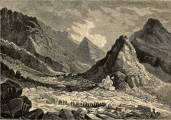


Santa Barbara Mission, Santa Barbara, California
Uses of Locally Quarried Stone
Santa Barbara Mission & Lavanderia
Many of the following photographs of the Santa Barbara Mission show examples of how locally quarried stone was used in the construction of the Santa Barbara Mission and on the mission grounds. If you would like to read more about the Santa Barbara Mission and view more photographs, visit the sections about the California missions in the “History of Quarrying in California from the California Indians Up to Present Time” section of our web site. (These photographs were taken in mid-January, 2011, by Peggy B. Perazzo and Pat Perazzo.)
Continued on Page 1 2
 |
 |
 |
Left side of the front of the Santa Barbara Mission |
Center of the front of the Santa Barbara Mission |
Fountain and center portion of the Santa Barbara Mission |
 |
 |
Right side of the front of the Santa Barbara Mission tower |
Closeup of the buttress at the Santa Barbara Mission tower |
x |
 |
Cassie Perazzo in front of the Santa Barbara Mission & Moorish fountain |
Moorish fountain built in 1808 located in the front of the Santa Barbara Mission |
Signs located at the Santa Barbara Mission Lavanderia
(small sign above)
“This lavanderia or wash basin was completed in 1818. It served as the original mission laundry. The Indians soaped the clothes on the sloping sides and rinsed them in the center pool.”
(large sign above)
“This clothes washing basin or lavanderia was built by the Chumash Indians of Santa Barbara Mission village in 1808. Not all missions built such a structure. The Chumash particularly valued cleanliness and worked to construct this lavanderia fed by water from the complex aqueduct system. The only other colonial lavanderia, which survives intact, is at Mission San Luis Rey near Oceanside. Note the finely carved mountain lion’s head forming the south spout, which was carved by a Chumash artisan and may be the oldest public sculpture in California. (The Bear’s head on the north end is a modern replica.)….”
“Landscaping around this lavanderia features native and colonial period plant varieties. Along the west (driveway) side from the north (fountain) end to the south various historic rose varieties are found interspersed with mission period cacti and perrenials (sic). The roses are from the north end, the native Rosa californica, then the colonial import, Rose of Castile propagated from historic stock found at Mission San Antonio. Farther south is the “Kinevan Rose” from the stagecoach stop on San Marco Pass, a mid-nineteenth century variety from a ranch that gathered its orchard cuttings from Santa Barbara Mission stock. At the Southwest fence corner is a Mission grape variety collected from Mission San Jose. Starting at the top (north) of the east fence plantings include the native “Rogers Red” grape and a selection of imported colonial period grapes collected from various and Mission and rancho sites (Mission San Jose, San Gabriel, La Purisima and various Santa Barbara County ranchos). The Chumash of this area successfully cultivating these grapes originating the wine industry in Santa Barbara County.”
Continued on Page 1 2
Commercial use of material within this site is strictly prohibited. It is not to be captured, reworked, and placed inside another web site ©. All rights reserved. Peggy B. and George (Pat) Perazzo.











